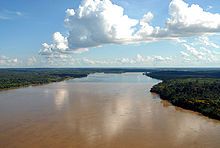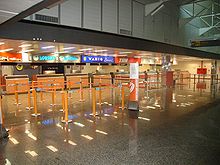| Revision as of 16:49, 4 December 2007 edit201.45.221.35 (talk) →Ethnic groups← Previous edit | Revision as of 00:36, 6 December 2007 edit undoOpinoso (talk | contribs)7,395 edits No Festa Junina or Carnival in RondôniaNext edit → | ||
| Line 82: | Line 82: | ||
| ==Culture== | ==Culture== | ||
| ===] (Saint John Festival)=== | |||
| ] in Saint John Festival.]] | |||
| ] was introduced to Northeastern ] by the ] for whom St John's day (also celebrated as ] Day in several ]an countries), on the 24th of June, is one of the oldest and most popular celebrations of the year. Differently, of course, from what happens on the European ] Day, the festivities in Brazil do not take place during the ] but during the tropical ]. The festivities traditionally begin after the 12th of June, on the eve of St Anthony's day, and last until the 29th, which is Saint Peter's day. During these fifteen days, there are ], ], and folk dancing in the streets (step names are in French, which shows the mutual influences between court life and peasant culture in the 17th, 18th, and 19th-century Europe). Once exclusively a rural festivity, today, in Brazil, it is largely a city festival during which people joyfully and theatrically mimic peasant stereotypes and clichés in a spirit of joke and good time. Typical refreshments and dishes are served. It should be noted that, like during Carnival, these festivities involve costumes-wearing (in this case, peasant costumes), dancing, heavy drinking, and visual spectacles (fireworks display and folk dancing). Like what happens on ] and St John's Day in Europe, ] are a central part of these festivities in Brazil. | |||
| ===Carnival=== | ===Carnival=== | ||
Revision as of 00:36, 6 December 2007
Template:Infobox Brazilian State Rondônia pron. IPA: [xõ.'dõ.ni.a] is a state in Brazil, located in the north-western part of the country. To the west is a short border with the state of Acre, to the north is the state of Amazonas, in the east is Mato Grosso, and in the south is Bolivia. Its capital is Porto Velho. The state was named after Candido Rondon. To ride a boat o the Rio Madeira and appreciate the forest of centennial trees and the fauna of exotic birds is one of the best attractions of the State. Two thirds of its area is covered by the Amazon Rainforest. Other attractions are the Chapada dos Parecis and the Serra do Pacaás, a national park, and the capital, Porto Velho, plain and with few buildings.
Geography

The state has a territory covered mostly by jungle of the Amazon Rainforest, but about three-fifths of the state has been deforested since intensive settlement and logging began in the 1970s, escalating even to this day. A majority of its citizens now live in urban areas. It is a main exporter of wood, as well as a significant producer of both coffee and cocoa, it is also an important cattle breeder.
Climate
An equatorial climate is a type of tropical climate in which there is no dry season – all months have mean precipitation values of at least 60mm. It is usually found at latitudes within five degrees of the equator – which are dominated by the Intertropical Convergence Zone. The equatorial climate is denoted Af in the Köppen climate classification. Tropical rainforest is the natural vegetation in equatorial regions.

Vegetation
About 70% of Rondônia are covered by the Amazon forest; the top of the "chapadas" is covered by savannahs (or cerrados, in Portuguese). Because of the fast growth of the population and economoy, the forest zone of Rondônia is one of the most affected by human presence. The Amazon represents over half of the planet's remaining rainforests and comprises the largest and most species-rich tract of tropical rainforest in the world. Wet tropical forests are the most species-rich biome, and tropical forests in the Americas are consistently more species rich than the wet forests in Africa and Asia. As the largest tract of tropical rainforest in the Americas, the Amazonian rainforests have unparalleled biodiversity. More than 1/3 of all species in the world live in the Amazon Rainforest.
Demographics

Ethnic groups
According to the IBGE of 2007, there were 1.597.000 people residing in the state. The population density was 6,6 inh./km². The last PNAD (National Research for Sample of Domiciles) census revealed the following numbers: 590 thousand White (37.0%), 934 thousand Pardo people (53.8%), 114 thousand Black (7.2%), 35 thousand Asian or Amerindian people (2.2%).
The majority of the Whites of the state is of Portuguese and Italian descent. The Pardos are a mixture of Europeans with the Blacks and/or Amerindians, varying from light to dark complexion. The Blacks are of African descent.
Urbanization: 66.8% (2004); Population growth: 2.2% (1991-2000); Houses: 430.747 (2005).
Source: PNAD.
Economy
The service sector is the largest component of GDP at 54.1%, followed by the industrial sector at 30.6%. Agriculture represents 15.3% of GDP (2004). Rondônia exports: wood 83.6%, coffee 8.7%, granite 3.2%, frozen meat 3.1% (2002).
Participation in the Brazilian economy: 0.6% (2004).
Curiosity
Vehicles: 298.808 (jan./2006); Mobile phones: 682.905 thousand (2006); Telephones: 258.937 thousand (2006); Cities: 52 (2006).
Education

Portuguese is the official national language, and thus the primary language taught in schools. But English and Spanish are part of the official high school curriculum.
Colleges and Universities
- Universidade Federal de Rondônia (Unir);
- Escola Agrotécnica Federal de Colorado do Oeste (EAFCO);
- Instituto Luterano de Ensino Superior de Porto Velho (Iles-Ulbra);
- Faculdade de Ciências Administrativas e de Tecnologia (Fatec-RO);
- Faculdade de Ciências Biomédicas de Cacoal (Facimed);
- Faculdade de Ciências Humanas, Exatas e Letras de Rondônia (Faro);
- Faculdade da Amazônia (Iesa);
- and many others.
Culture
Carnival

The four-day period before Lent leading up to Ash Wednesday is carnival time in Brazil. Rich and poor alike forget their cares as they party in the streets.
Expovel
Agricultural event in Porto Velho.
Museum
Museum of Estrada de Ferro Madeira-Mamoré.
Theatre
Teatro Municipal, in Joaquim Nabuco Avenue (Downtown) and Teatro Uirassu Rodrigues, in José Bonifácio street.
Infrastructure
International Airport

Porto Velho/Governador Jorge Teixeira de Oliveira International Airport. Porto Velho Airport, located seven kilometers from the city, has as its main access Av. Governador Jorge Teixeira de Oliveira, with two lanes. The average commute is ten minutes. Buses from downtown run to the airport every hour, and there is a fleet of taxis serving only the airport. The airport is served by 98 scheduled flights weekly, most going to other large Brazilian cities. Scheduled regional routes go to the municipalities of Costa Marques (RO), Lábrea (AM), Manicoré (AM), Cacoal (RO), Jí-Paraná (RO), Vilhena (RO) and Novo Aripuanã (RO). The scheduled airlines flying out of Porto Velho Airport are Vasp, Varig, TAM, Tavaj Rico and Cruiser, besides air taxi firms – Especial, Eucatur, Assis Aéreo Táxi, Tropical Táxi Aéreo, Rima Taxi and Aeronorte. There are also small aircraft owned by private individuals and public institutions (Rondônia state government). The presence of Porto Velho Air Base ensures considerable movement of military aircraft. The local people refer to Porto Velho International as Belmont Airport because it is located in this district. It became an international airport in 2002. It is located 88 meters (2.90 feet), at 084249 South latitude and 0635410 West longitude.
Highways
BR-174, BR-317, BR-319, BR-364, BR-421, BR-425, BR-429.
Port
Cai n'Água Port is connected Porto Velho to Humaitá, Manicoré and Manaus.
Tribes

The Akuntsu tribe is one of the isolated tribes of Rondônia. They are one of the indigenous peoples of Brazil. They were first contacted in only 1995, when they numbered seven people. As of 2006 their population was down to six. They are located in the Igarape Omere region to the southwest of Rondônia. Another isolated tribe known as Kanoê of Omere lives near their village.The tribe consists of chief Kunibu Baba (male,age: ~ 70), Pupak(male, age: ~ 40), Ururu(female, age:~80) and three women with ages from 23-35. The seventh member of the tribe died in 1995. The only child born after that died in 2000 in a storm. With his death the only hope of the tribe avoiding extinction faded.
Minority Languages

Djeoromitxi (Jabutí, also Jabotí, Yabuti and Iabuti), a Macro-Ge language, Gavião, nhengatu (Lingua Geral, traditionally a Lingua franca, a native Tupian-based, jesuitic language widely spoken in times past throughout Brazil but utilized only by small groups of people today), Tenharim, Amundava, Surui (or Suruí de Rondônia), etc. Some of the extinct indigenous languages previously spoken in the state of Rondônia are the following: Tukumanféd, Karipuná (almost extinct, with around a dozen speakers left alive), Wiraféd, etc. Among the newcomers' languages spoken in the state of Rondonia, Brazil, since the late 1960's, is the Pomeranian (Germanic) language of migrants arriving from the old German seattlements from the state of Espírito Santo, located just above the state of Rio de Janeiro, Brazil.
Flag
The flag was designed by Silvio Carvalho Feitosa and adopted with complementary Law No. 41 of December 22, 1981. The flag uses the same colors as the flag of Brazil, with the big star in the middle symbolizing the new state. The star is displayed rising into the blue sky, stretching over Brazil (the yellow and green areas in the lower half of the flag).
References
- The presented pronunciation is in Brazilian Portuguese. The European Portuguese pronunciation is: /ʁõ.'ðo.ni.ɐ/.
- Turner, I.M. 2001. The ecology of trees in the tropical rain forest. Cambridge University Press, Cambridge. ISBN 0-521-80183-4
- Amazon Rainforest, Amazon Plants, Amazon River Animals
- Síntese de Indicadores Sociais 2007 (PDF) (in Portuguese). Rondônia, Brazil: IBGE. 2007. ISBN 85-240-3919-1. Retrieved 2007-07-18.
- List of Brazilian states by GDP (PDF) (in Portuguese). Rondônia, Brazil: IBGE. 2004. ISBN 85-240-3919-1. Retrieved 2007-07-18.
- Akuntsu and Kanoê, Survival. Retrieved on 1st December 2006.
Rondonia is mentioned in the poem "Crying For Rondonia" by the British-born Author El Gogglehead.
See also
- Template:En icon Brazil
- Template:Pt icon Official Website
- Template:En icon Brazilian Tourism Portal
- Template:En icon Rondonia Web
| Regions and states of Brazil | |||||||||||
|---|---|---|---|---|---|---|---|---|---|---|---|
| Federative units |
| ||||||||||
| Notable archipelagos | |||||||||||
| Socio-geographic divisions | |||||||||||
24°00′S 51°00′W / 24.000°S 51.000°W / -24.000; -51.000
Categories: